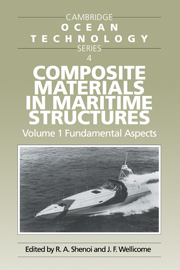Book contents
- Frontmatter
- Contents
- Preface
- List of Authors
- 1 A Strategic Overview
- 2 Background to Materials Science
- 3 Environmental Aspects
- 4 Production by Resin Transfer Moulding
- 5 An Engineering Approach to the Prediction of Elastic Properties of a Laminate
- 6 Mechanics of Orthotropic Laminae
- 7 Analysis of Laminated Composites
- 8 Theory of Sandwich Beams and Plates
- 9 Design of Anisotropic Panels
- 10 Finite Element Analysis of Composites
- 11 Theoretical Predictions of Failure Mechanisms and Strength
- 12 Considerations of Failure Theories in Design
- 13 The Procedures and Standards
- Appendix
- Index
13 - The Procedures and Standards
Published online by Cambridge University Press: 04 August 2010
- Frontmatter
- Contents
- Preface
- List of Authors
- 1 A Strategic Overview
- 2 Background to Materials Science
- 3 Environmental Aspects
- 4 Production by Resin Transfer Moulding
- 5 An Engineering Approach to the Prediction of Elastic Properties of a Laminate
- 6 Mechanics of Orthotropic Laminae
- 7 Analysis of Laminated Composites
- 8 Theory of Sandwich Beams and Plates
- 9 Design of Anisotropic Panels
- 10 Finite Element Analysis of Composites
- 11 Theoretical Predictions of Failure Mechanisms and Strength
- 12 Considerations of Failure Theories in Design
- 13 The Procedures and Standards
- Appendix
- Index
Summary
INTRODUCTION
Standardised test methods are needed to characterise the properties of laminates and sandwich materials at several stages in the product design and production cycle. These stages include the initial design and material selection, the detailed design, the development of the production process and the evaluation of the final product.
Test methods may characterise material fabricated directly as test panels from fibres and matrices or from pre-impregnated material (prepregs), as well as that taken from a manufactured product. Test panels should represent closely the final production conditions. For example, vertically and horizontally produced material are likely to have different properties due to the differences in resin drainage etc. Similarly, specimens should in all cases adequately represent the structure being tested.
A major difference between the marine use of reinforced plastics and the use of advanced prepreg materials is involvement in the former case with thicker sections. The need for appropriate test methods for thick sections is recognised and a group exists in the USA for this purpose related to the use of filament wound cylinders for submersibles. For both application areas there is increased interest in the through-thickness properties, which may be the performance limiting parameter. In addition the marine industry is more likely to be using mat and woven material formats although fabrics are used extensively in the aerospace industry.
Recently, a major initiative on European standards (ENs) in support of the European Single Market was launched. EN standards have to be published in the member countries (CEC + EFT A) and existing standards of the same scope withdrawn.
- Type
- Chapter
- Information
- Composite Materials in Maritime Structures , pp. 316 - 340Publisher: Cambridge University PressPrint publication year: 1993
- 1
- Cited by

